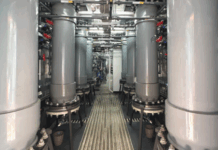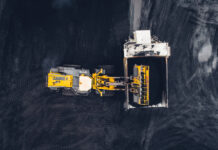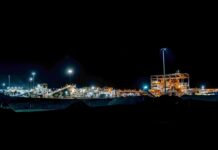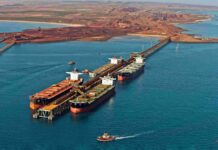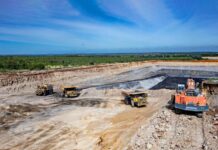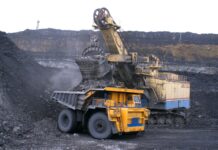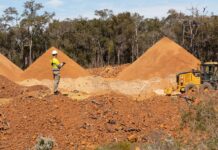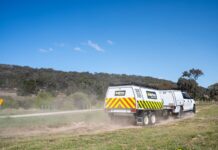When a crucial machine or equipment breaks down on-site, the potential impact is worth millions of dollars in revenue to a well-run mining operation.
The sudden, unexpected halting of production puts the mine site team on the critical path to getting repairs or replacements done in as short a time as possible.
Downtime equals loss. Reliability, durability and safety are paramount. In the most remote, high-risk and harshest environments in Australia, all machinery and equipment at mine sites must perform 100% of the time.
Power and lighting are vital to these 24/7 operations.
The Australian Mining Review spoke to PowerLink Australia Sales Director, Sidney Ji, and Lighting Tower Product Manager, John Mikic, to learn how the company’s range of gensets and lighting towers solve the issues of reliability and robustness for mine site power and lighting generation.
PowerLink Australia
PowerLink, founded in 2001, is a global manufacturer and supplier of reliable and high-performing power equipment, with research and development centres across the world.
In 2010, PowerLink Australia was established, serving Australia, New Zealand, Papua New Guinea and the Pacific Islands.
The parent group, PowerLink, first supplied diesel generators to clients in Australia in 2006, prior to PowerLink Australia being established.
Local clients recognised the quality and value of PowerLink power equipment, with the company importing the products into Australia well before 2010.
Today, with the head office located in Sydney, more than 8000 pieces of PowerLink Australia power equipment are used throughout the Oceania and South Pacific region, of which nearly 7000 pieces are used throughout Australia.
Design and Engineering
PowerLink Australia Sales Director, Sidney Ji, says the company has focused on designing and engineering products suitable for Australian remote and harsh environments for the past 15 years.
“Our generators are reliable, very robust, easy to operate and most of all safe to work with, complying with Australian local safety standards such as the basic requirements of AS3000 and AS3010,” he said.
Committed to supporting clients’ business growth, PowerLink Australia prides itself on reliable products that exceed Australian Standards and are operationally-safe.
“As a standard, our gensets come with four-pole circuit breakers. We also upgrade products to relevant minespecs and use only proven parts and components, including reputable diesel engines such as Cummins, Perkins and Kubota,” Sidney said.
High-Performing Gensets
Able to withstand temperatures up to 50o Celsius, highly wear resistant, anti-corrosive with galvanised steel canopy and a rigid chassis, PowerLink Australia gensets can be used on remote land or even by the sea.
Multiple genset sizes are available and can be synchronised to deliver higher output.
There could be a 30kVA generator providing backup power for an onsite pump, or there could multiple of 500kVA generators synchronised together to power up a mining camp.
Sidney says all the clients have to do is put diesel into the engines to get started.
“Generators are the core and heart of energy source and that’s why we only use world-renowned and reputable engines. Cummins is one of the world’s number one diesel engine manufacturers that has proven engines and the company invests heavily in improving technology, translating to better fuel efficiency and more robust engines for clients,” he said.
All PowerLink Australia gensets are powered by world-renowned diesel engines such as Cummins, Kubota and Perkins.
They are supplied complete with four-pole ABB circuit breakers, smart controllers, lockable access doors and other features suitable for daily heavy-duty needs.
Reliability
The mining environment in Australia is dusty and polluted.
Products that work overseas may not be suitable for local applications and conditions.
Potential issues around variable load and the clogging of systems due to pollutants could create a mining operation disaster.
“Reliability isn’t just about engineering and design, products must be able to withstand the harsh and difficult environments of remote mine sites. When products fail, this leads to big losses at the clients’ operations worth millions of dollars. We work towards the final end-use of the product in everything we do,” Sidney said.
A European product that works well in cooler and cleaner air environments may be unsuitable for mine sites in Australia where temperatures regularly push over 50°C.
“Reliability is an absolute focus for PowerLink Australia. We do not believe in cutting corners or finding cheaper substitutions for genuine, quality products. It only takes one part to fail for the whole machine to turn down. Our chosen products are tough, reliable and high-performing, proven through our years of operation in Australia,” Sidney said.
PowerLink Prime Range
The PowerLink Prime range is the company’s premium range developed for all types of the heavy-duty applications.
Featuring an auto-transfer switch, the smart technology embedded in these range of gensets determines when power is out and automatically powers up the generator for continuous power supply.
This premium range is suitable for high-volt applications in harsh environments such as mining in remote areas, power stations and telecom projects.
The option of housing the larger gensets in shipping containers presents a cost-saving to clients with transport and shipping.
The PowerLink QSV range, on the other hand, was developed for the standby market application, including, commercial, agriculture or industrial backup applications. Both ranges come with canopy boxes which reduce sound, while also supporting the genset in a rigid, sturdy frame.
Exceptional Service
The two supply centres in NSW and WA ensure fast delivery of power equipment and minimal downtime for clients.
Dedicated technical service teams at these two locations and a nationwide service network deliver exceptional after sales support and service.
PowerLink Australia also has unparalleled domain expertise, with 15 key distributors that are highly experienced in diesel generators and 24 service depots throughout the country.
A variety of stock is always on hand, leading to minimal downtime for clients.
Rest assured knowing that access to expert product knowledge and technical expertise at PowerLink Australia is only a phone call away.
Backed up by strong CRM systems, critical information such as parts availability, technical specifications, maintenance schedules and technical drawings are always at hand.
“That’s our commitment to local Australian customers,” Sidney said.
“We supply a product, but we also supply the service, support and training. All feedback we receive from clients goes back into further research and development and the manufacturing process.
“Product improvement is a continuous journey for PowerLink Australia and we take pride in product quality and efficiency for the end user.”
Lighting Towers
PowerLink Australia Lighting Tower Product Manager, John Mikic, says the central topics around lighting towers are fuel efficiency and reliability for the end users.
With mines operating around-the-clock, visibility and good lighting conditions 24/7 are paramount in ensuring non-stop production.
Lighting tower equipment must perform in harsh environments, alongside the elements of wind, rain, dust; along with having a simple, continuous operation, the equipment must be robust, unequivocally stable on unlevel surfaces and be transportable across bumpy terrain.
A huge ask of a small machine.
ALT2000
No challenge is too tough for the ALT2000 mobile light tower, a heavy-duty, off-road diesel equipment made for the mining industry.
The most powerful among PowerLink Australia’s four flagship lighting towers, this machine weighs in at nearly 2t, with the other three machines weighing about 1t each. This MDG15/41 minespec lighting tower, suitable for open-cut mining and used in NSW coal mines, uses high quality, high output LED light fixtures at 500W per unit.
Featuring a reliable two-cylinder Kubota Z482-E4B-ACP-1 engine and an LCD panel built into its powder-coated canopy, this lighting tower allows for precise electronic control of light output, height and tilting through its inbuilt control system.
The PLC-810 microprocessor controller allows for easy operation and maintenance.
It also comes with a 12V/120AH sealed-for-life and maintenance-free battery, allowing the lighting tower to be powered when not connected to grid or in the absence of fuel.
The DC/VF alternator PMG-DC-18-4 directly charges the battery.
With four 500W metal LED lamps, hydraulic power driving the lamp post, an emergency stop switch, an Anderson jump start socket, lockable battery isolator switch and programmable alarm functions, the ALT2000 lighting tower is a power-packed machine adopting a mobile trailer design and four supporting legs to install the lighting tower.
Having a rating of IP65 makes the entire machine highly resistant to external elements.
IP or Ingress Protection, also known as International Protection, is a two-digit grading system applied to the enclosure of mechanical or electrical items.
It grades the level of protection for the user, the degree of protection from elements and the resistance to moisture.
Fully extended, the lighting tower dimensions are 4237mm x 2936mm x 8418mm with up to a 90o tilting of the lights.
The quality and build of the ALT2000 is unparalleled with its world-leading design, engineering and quality using only the best proprietary LED technology.
Fuel Efficiency
When performance requirements are high and cost input is low, diesel run lighting towers provide the most robust and economic option for mine sites. Factors including application, size, colour, temperature, glare, noise, light spill, energy and fuel efficiency, IP rating and regulations all contribute to the type of lighting towers chosen by end-users.
The ALT2000 has a 200L tank capacity with fuel consumption at 50Hz. The running of four lamps uses just 0.76l of fuel per hour.
Reducing the usage down to two lamps further drops fuel consumptions to just 0.48l per hour.
The output of the generator is determined by the load, with diesel generators consuming less fuel overall.
Lighting Efficiency
With the progression of lighting technology over the last decade, the use of metal halide lamps was slowly replaced by more efficient, more resilient and longer-life LED lights.
The LED light fixtures on the ALT2000 are 500W per unit and have separate control gear and a large heat sink which help to keep the LED at optimum performance.
Lumens per watt play a huge role in the efficiency of lighting towers. The higher the lumen per watt, the more output is provided for less power.
John believes lighting efficiency can only improve from here on, with more lumens producing per watt and reducing energy draw.
Battery Efficiency
Lithium batteries are currently used in lighting towers and are expected to be replaced by solid state batteries in the next few years.
These new technology batteries are made up of solid material, electrodes and electrolytes, instead of the liquid or gel ones found in lithium batteries.
“The introduction of solid state batteries will solve the issue of efficiency and reliability. These new technology batteries will be about half the size of the current lithium ones and will provide about five times as much power output,” John said.
“Current compact batteries that power standard lighting towers can run about seven days straight on a 90L diesel tank. The mine spec lighting towers such as the ALT2000 have a much bigger tank at 200L and can run up to 152hrs, or just under 13 days at 12 hours per session.”
John said roadwork tunnels in Sydney currently employ battery-powered lighting towers, with the option of running power cables and connecting these towers to externally located generators to combat air and noise pollution within the tunnels.
“With the advent of solid state batteries, we are hopeful this will provide a solution for end-users who prefer hybrid lighting towers in terms of performance, longevity and costsavings for near-daylight illumination,” he said.
Other models
The other three flagship models of diesel lighting towers offered by PowerLink Australia, all weighing in about one tonne each, are:
- MS1800-KDC: adopting a trailer design, this lighting tower features a cover over the individual lighting fixtures that create soft lighting for the end user.
- MS2000-KDC: similar in body design to the MS1800-KDC, this lighting tower features conventional LED lighting.
- FS2000-KDC: this lighting tower has a fixed, stable base but the body, mast and lighting fixtures have the same design and functionality as the MS2000.
SOURCE
Powerlink Australia
P +61 2 8858 9688
E sales.au@powerlinkworld.com
W www.powerlinkworld.com.au


